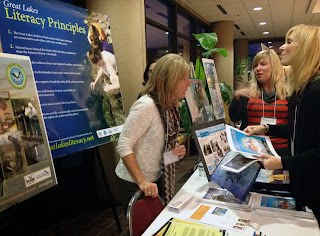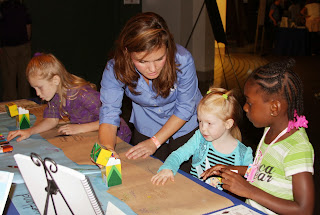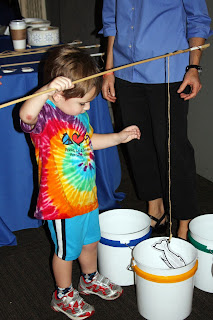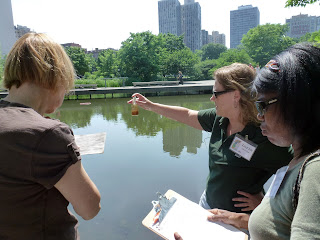June 17th, 2014 by iisg_superadmin
The efforts of an Illinois teacher to bring Great Lakes science into the classroom were brought center stage in the latest edition of Teacher Features, a monthly online series that showcases outstanding educators in the Great Lakes region.
Eileen DeJong, a teacher at Suak Village’s Rickover Junior High, is one of 14 teachers from Illinois and Indiana who learned about local aquatic ecosystems and ideas for hands-on stewardship activities at last summer’s B-WET workshop. In this edition, she talks about the importance of raising awareness of Great Lakes issues, past classroom projects, and her plans for the future.
From Teacher Features:
1. Why do you think it’s important to infuse Great Lakes topics in education?
I think it’s important that I incorporate information about our Great Lakes into my teaching because our school is impacted in many ways by one of the Great Lakes (Lake Michigan). Students respond to information that makes sense to them and that affects their life, and because Lake Michigan is so close to us (within 45 minutes); it’s a great way to get students involved in current environmental issues. We can study about aquatic invasive species affecting Lake Michigan and then GO TO Indiana Dunes, for example, and conduct experiments there. Or … even closer to home, we can study about invasive species harming our local forests, and then GO TO nearby forest preserves and volunteer. It’s all about making connections. Studying the Great Lakes topics make science REAL for my students and helps foster natural curiosity about their surroundings. It is also important because the problem of invasive species is a current environmental issue, and it’s happening in our own backyard. It encourages my students to become knowledgeable about factors affecting their living environment and to become activists for change.
Continue reading at the link above.
Teacher Features is part of the Center for Great Lakes Literacy’s (CGLL) ongoing efforts to boost awareness of issues facing the Great Lakes watershed and inspire greater community stewardship. The group is led by Sea Grant educators throughout the region and conducts numerous teacher trainings each year, including the annual Shipboard Science workshop.
November 15th, 2013 by Irene Miles
The 3rd Annual Great Lakes Place-based Education Conference, November 7-9 in Grand Rapids, Michigan, brought together over 200 teachers, community representatives, non-profit organization educators, and more. The conference gives teachers an opportunity to incorporate the latest place-based research and education concepts about the Great Lakes into their lessons, encouraging student stewardship, continuing science education, and community development.
 IISG’s Robin Goettel attended the conference and organized a poster session, “Center for Great Lakes Literacy: Connecting Educators, Scientists and Citizens.” The Center for Great Lakes Literacy (CGLL) “engages educators, students, scientists, and lifelong learners in stewardship and citizen science activities to help protect and restore Great Lakes watersheds.”
IISG’s Robin Goettel attended the conference and organized a poster session, “Center for Great Lakes Literacy: Connecting Educators, Scientists and Citizens.” The Center for Great Lakes Literacy (CGLL) “engages educators, students, scientists, and lifelong learners in stewardship and citizen science activities to help protect and restore Great Lakes watersheds.”
According to Robin, “A major focus of this exhibit was creating awareness of Great Lakes Literacy Principles – a great foundation from which to create an environmental stewardship ethic. CGLL specialists shared exciting educator opportunities including ship-based and shoreline workshops focusing on the latest Great Lakes issues. Visitors learned about water quality monitoring equipment they can use with their students made available courtesy of the USEPA GLNPO Limno Loan program. Participants also found out about Great Lakes Awareness Days that will be offered throughout the region.”
 Representatives of the CGLL program from seven Great Lakes Sea Grant programs were on hand to talk with attendees about the wide array of resources available, many specifically tailored to the environmental needs and issues of their region. Classroom resources were also available, including Fresh and Salt and Greatest of the Great Lakes curricula, as well as the Dose of Reality newspaper activity guide that covers the disposal of unwanted medicines and personal care products.
Representatives of the CGLL program from seven Great Lakes Sea Grant programs were on hand to talk with attendees about the wide array of resources available, many specifically tailored to the environmental needs and issues of their region. Classroom resources were also available, including Fresh and Salt and Greatest of the Great Lakes curricula, as well as the Dose of Reality newspaper activity guide that covers the disposal of unwanted medicines and personal care products.
October 16th, 2013 by Irene Miles
Earlier this month IISG and several other organizations participated in Great Lakes Awareness Day at Shedd Aquarium. The event featured 10 interactive exhibits that introduced visitors to Great Lakes issues and showed them what they can do keep the Lakes healthy.
IISG science writer Anjanette Riley had this to say about the event:
 “To put it bluntly, Great Lakes Awareness Day was a huge success. There was maybe only a moment or two during the 3-hour event that exhibits weren’t crowded with people ready to learn more about aquatic invasive species, habitat restoration, and pollution from unwanted medications and unnecessary lawn care products. In the back-lit glow of the aquarium’s Water of the World galleries, children and adults became detectives on the hunt for aquatic invaders, saw how pollutants from streets and lawns flow into waterways with the help of a three-dimensional model, tested their knowledge of pharmaceutical pollution, and drew pictures of plants and animals important to Great Lakes health. Perhaps the biggest hit of the day was Spin-Fish-Win, an aquatic invasive species (AIS) trivia game.
“To put it bluntly, Great Lakes Awareness Day was a huge success. There was maybe only a moment or two during the 3-hour event that exhibits weren’t crowded with people ready to learn more about aquatic invasive species, habitat restoration, and pollution from unwanted medications and unnecessary lawn care products. In the back-lit glow of the aquarium’s Water of the World galleries, children and adults became detectives on the hunt for aquatic invaders, saw how pollutants from streets and lawns flow into waterways with the help of a three-dimensional model, tested their knowledge of pharmaceutical pollution, and drew pictures of plants and animals important to Great Lakes health. Perhaps the biggest hit of the day was Spin-Fish-Win, an aquatic invasive species (AIS) trivia game.
No matter what part of the event they joined in on, though, these Shedd visitors were clearly interested in talking about important Great Lakes issues–sharing what they know and asking questions about what they didn’t. People I talked with were particularly interested in learning more about Asian carp, asking questions like “what makes them so bad,” “what can we do to stop their spread,” and even “can’t we just eat them?” Visitors were also surprised to learn about the impact pharmaceuticals have on fish and other aquatic organisms and wanted to know how they could safely rid their cabinets of unwanted medicines. And a father and his son took advantage of an AIS art contest to clear up rumors they had heard about some invaders and get up to date on the newest species knocking on the Great Lakes’ door.
 Joining IISG staffers at the event were teachers and students from area schools who came to share what they are doing in their communities to protect water quality and aquatic wildlife. LaToyia Gilbert and her students talked about bringing medicine disposal ‘dos and don’ts’ to citizens and pharmacy technicians in Gary, IN.
Joining IISG staffers at the event were teachers and students from area schools who came to share what they are doing in their communities to protect water quality and aquatic wildlife. LaToyia Gilbert and her students talked about bringing medicine disposal ‘dos and don’ts’ to citizens and pharmacy technicians in Gary, IN.
Latoyia was inspired to create this project based on what she learned at the recent Great Lakes B-WET workshop. Jim Doyiakos and students from Amundsen High School introduced visitors to the risks of invasive species. And Ronald Hall’s 41st Street Beach Eco Warriors from Evergreen Academy Middle School shared their experiences picking up trash and monitoring water quality at Chicago’s 41st Street Beach.
 Thanks to a Shedd Aquarium teacher workshop going on that same day, some of the people who stopped by the exhibits were also teachers looking for ways to bring Great Lakes science into their classrooms. Many of these teachers took pictures of the displays or copies of the handouts so they could replicate the activities later. Others sought advice from teachers manning exhibits about potential stewardship projects they could do with their students. One teacher who helped with the event even asked if it could be repeated in the spring so her students could present their own projects.”
Thanks to a Shedd Aquarium teacher workshop going on that same day, some of the people who stopped by the exhibits were also teachers looking for ways to bring Great Lakes science into their classrooms. Many of these teachers took pictures of the displays or copies of the handouts so they could replicate the activities later. Others sought advice from teachers manning exhibits about potential stewardship projects they could do with their students. One teacher who helped with the event even asked if it could be repeated in the spring so her students could present their own projects.”
GLAD was coordinated by IISG as part of a Center for Great Lakes Literacy regional initiative.
October 9th, 2013 by Irene Miles
This past summer’s B-WET workshop offered a lot of lesson and activity ideas for all of the teachers who attended, including Marea Spentzos-Inghram, middle school teacher at Catherine Cook School in Chicago.
Beyond just taking a few curriculum ideas back to her lesson prep, though, Ms. Spentzos-Inghram decided to turn her class into student scientists by becoming official precipitation observers for CoCoRaHS – the “Community Collaborative Rain, Hail, and Snow Network” – which is a volunteer network of weather watchers throughout the country. The project was even featured in the school newsletter (photo below).
“The B-WET workshop presented teachers with so much information it would be impossible to not get inspired!” said Ms. Spentzos-Inghram. “They had a lineup of AMAZING presenters from a variety of organizations to promote their efforts, which made it a one-stop shop for information about bringing Great Lakes science into the classroom.”
“Being an urban school, I felt limited in outdoor environmental opportunities but CoCoRaHs was do-able. Since I have rooftop access to my building it was easy to participate! And the students get REALLY excited when it rains because they want to see how much rain fell at our school. I can’t imagine what it will be like for snow (or other precipitation).”
Ms. Spentzos-Inghram has expanded on this experience and introduced an outreach component, with a group of students working on a PSA right now featuring a cartoon rain gauge being interviewed.
As for the benefits of the workshop, “what they had to share seemed easy (teachers like easy) yet practical, useful, and educational. And the students have really taken to it and gotten involved, which is the best part of coming back with new ideas for the classroom.”
Similar workshops are held regularly, and you can contact IISG’s Robin Goettel and Terri Hallesy for more details. You can find additional information about Great Lakes science resources and training at our education page and at the Center for Great Lakes Literacy.
July 16th, 2013 by Irene Miles
“Thank you for providing an awesome, informative, and very educational workshop,” said one teacher after last month’s B-WET field experience. “It was extremely helpful to me and, as a result, I feel very confident in addressing my students regarding the Great Lakes, knowing that now I have a plethora of resources, information, lessons, etc. at my disposal.”
All of the attendees at this year’s B-WET Field Experiences for Watershed Educators workshop shared similar positive feedback on the experience, and were genuinely excited at the opportunity to expand their science lessons. IISG’s education team led last month’s four-day training for teachers in Illinois and Indiana, where participants gained new hands-on skills and knowledge from invited speakers to take back to their classrooms.
 Teachers got to see a number of practices in action, including habitat restoration at Cowles Bog, a remediated and revitalized Roxana Marsh, water quality testing at the Peggy Notebaert Nature Museum pond, and more. They also got their hands dirty planting native species and performing a beach cleanup.
Teachers got to see a number of practices in action, including habitat restoration at Cowles Bog, a remediated and revitalized Roxana Marsh, water quality testing at the Peggy Notebaert Nature Museum pond, and more. They also got their hands dirty planting native species and performing a beach cleanup.
The workshop was designed explicitly to provide educators with a way to connect classroom concepts and scientific principles with real-world examples of watershed stewardship in action. Teachers engaged in fieldwork and collaborated with participating agency and organization educators who shared their program examples. As a result, teachers will be able to offer their students information that complements their science curricula. Additionally, the workshop gave them a chance to brainstorm new activities and lessons they could use with their students this fall.
Terri Hallesy, Illinois-Indiana Sea Grant education specialist explained, “As a result of this workshop, students will develop awareness and understanding about these critical environmental watershed issues based on the teachers’ new understandings. Educators will bring this increased confidence to their students to help excite them about engaging in Great Lakes stewardship.”
Added Rafael Rosa, Vice President of Education at the Peggy Notebaert Nature Museum, “What I was most impressed with was the enthusiasm of the teachers the program attracted. They asked great questions and more importantly were very open to sharing ideas and working with one another. I think I learned as much from them as they did from me.”
Funding was provided through a grant from the NOAA B-WET education program (linked above), and the workshop was made possible with assistance from Indiana Dunes State Park, the Great Lakes Research and Education Center at Indiana Dunes National Lakeshore, and the Alliance for the Great Lakes.
July 10th, 2013 by Irene Miles
From Robin Goettel, IISG associate director for education:
Scientists and teachers had a unique opportunity to interact, network, and connect research with education during The Center for Great Lakes Literacy’s Educator Day at last month’s IAGLR 2013 conference in West Lafayette, Indiana. Among the many goals of the IISG-coordinated session, providing opportunities for teachers to share their science education needs with researchers and identifying ways to incorporate the latest Great Lakes research into their lesson plans were high priorities.
The exchange of ideas was not only productive, but was a welcome and highly valued experience for all of the participants. The feedback received from both researchers and educators was outstanding, and offered a number of suggestions to guide another session like this in the future.
Said one teacher of the event, “I was impressed! My experience with IAGLR exceeded my expectations. I was hoping to simply gather more information to ‘grow’ my Great Lakes curriculum. However, I was able to network with other teachers and scientists which I found so much more valuable than walking away with a stack of Great Lakes lesson plans.”
Another educator was grateful for the opportunity to meet and talk to working researchers. “I am very thankful for the chance to interact with professionals in the field. Not only does attending scientific conferences refresh learned concepts, but allows for new learning, insight, and expansion of awareness. It also provided fresh ideas for project-based learning and the opportunity to network with potential collaborators.”
The participating scientists were also glad to brainstorm ways that their work could be incorporated into classroom lessons.
 “I always enjoy talking with teachers who are ‘in the trenches’ with younger students. They are faced with a different set of challenges (and opportunities) than we have at the college level. It was nice to hear that there are current efforts to better integrate math and science. It was also interesting to hear what teachers introduce in their classrooms to motivate and engage students in STEM areas.”
“I always enjoy talking with teachers who are ‘in the trenches’ with younger students. They are faced with a different set of challenges (and opportunities) than we have at the college level. It was nice to hear that there are current efforts to better integrate math and science. It was also interesting to hear what teachers introduce in their classrooms to motivate and engage students in STEM areas.”






